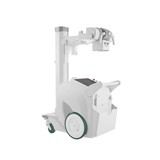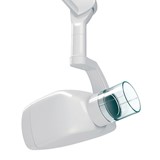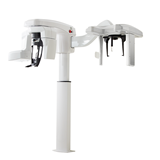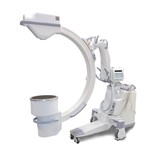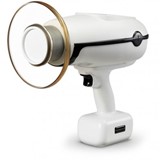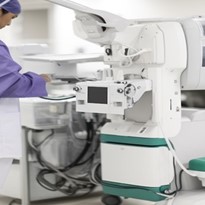In today's rapidly advancing healthcare landscape, the selection of the right mobile X-ray machine for your facility holds paramount importance. Mobile X-ray machines have become indispensable tools in modern healthcare settings, aiding in the swift and accurate diagnosis of various medical conditions. This guide, characterized by its informative, professional, and objective tone, aims to provide you with a comprehensive framework for making an informed decision when choosing a mobile X-ray machine for your facility.
I. Identifying Your Facility's Imaging Needs and Volume
A. Analyzing Patient Load and Workflow
- Determining the average number of patients who require X-rays:
To effectively choose the appropriate mobile X-ray machine, it is crucial to begin by assessing your facility's patient load. This involves tracking the number of patients who necessitate X-ray examinations on a regular basis. This data serves as the foundation for tailoring your imaging solutions to meet the actual demands of your healthcare institution
- .Assessing peak hours and potential bottlenecks:
Identifying peak hours and potential bottlenecks in your facility's workflow is essential for streamlining the imaging process. By analyzing when patient flow is at its highest and identifying potential workflow interruptions, you can optimize the utilization of your mobile X-ray equipment to ensure timely diagnoses.
- Considering the variety of medical cases:
Medical facilities often deal with a diverse range of cases, each requiring specific imaging protocols. Consider the variety of medical cases your facility handles, from routine check-ups to emergency trauma cases. Understanding these variations is pivotal in choosing a mobile X-ray machine capable of accommodating the breadth of diagnostic needs.
B. Required Imaging Modalities
- Defining the specific types of X-ray examinations needed (e.g., bone, chest, dental)
Clearly outline the range of X-ray modalities your facility offers. This includes specifying whether you perform specialized procedures like dental X-rays or require more general-purpose machines.
- Evaluating any future expansion or specialization plans:
Consider your facility's growth prospects. Are there plans to expand services or specialize in certain medical fields? Ensure that the selected mobile X-ray machine can adapt to these potential changes.
- Discussing the need for additional features like fluoroscopy:
If your facility necessitates advanced features like fluoroscopy for real-time imaging, discuss these requirements. Evaluate whether the chosen machine supports these capabilities and the associated technical specifications.


Find the right Mobile X-Ray Machine
Compare quotes from expert Australian suppliers and make the best choice. It's free, quick and easy!
II. Considering Portability, Size, and Weight of the Equipment
A. Assessing Mobility Needs
When selecting a mobile X-ray machine for your facility, it's crucial to begin by assessing your facility's specific mobility needs.
- Examining the physical layout of the facility: Start by closely examining the layout of your healthcare facility. Take note of corridors, doorways, and any potential obstacles that the mobile X-ray unit may encounter during its operation. This assessment will help you determine the required dimensions and maneuverability features.
- Determining if mobile X-ray units need to access tight spaces: Some healthcare facilities may have areas with limited space, such as intensive care units or emergency rooms. In such cases, it's essential to determine if the mobile X-ray unit needs to access these tight spaces without causing disruptions to patient care.
- Considering the need for easy maneuverability: Consider whether the X-ray machine needs to be easily maneuverable by your staff. This includes assessing the weight distribution, steering mechanisms, and control interfaces to ensure that it can be operated efficiently within your facility's layout.
B. Weight and Size Considerations
The weight and size of the mobile X-ray machine are critical factors that can impact its overall functionality and suitability for your facility.
- Exploring the balance between portability and image quality: Finding the right balance between portability and image quality is essential. While a smaller, lighter unit may be more maneuverable, it may compromise on image resolution. Evaluate your facility's imaging needs and determine the acceptable trade-offs between size and image quality.
- Evaluating storage and space constraints: Take into account the available storage space for the mobile X-ray machine when it's not in use. Ensure that it can be stored conveniently within your facility without causing congestion or hindering other essential operations.
- Discussing transport and deployment ease: Consider how easily the mobile X-ray machine can be transported to different areas of your facility, including patient rooms or operating theaters. Additionally, assess the ease of deployment and setup to minimize disruptions to patient care and workflow.
III. Assessing Imaging Resolution and Image Quality
When selecting a mobile X-ray machine for your healthcare facility, one of the critical factors to consider is the imaging resolution and image quality. These aspects play a pivotal role in ensuring accurate diagnoses and optimal patient care. In this section, we will delve into the technical aspects related to image quality and resolution, emphasizing their importance and how they impact your facility's imaging capabilities.
A. Image Resolution
- Understanding the Impact of Resolution on Diagnostic Accuracy
Image resolution refers to the level of detail and clarity that an X-ray image can provide. It is measured in terms of pixels or line pairs per millimeter (LP/mm). Higher resolution enables healthcare professionals to detect and analyze finer anatomical structures, making it crucial for accurate diagnosis.
- Why it Matters:
Higher resolution allows for the detection of subtle abnormalities, leading to more precise diagnoses.
- Explaining the Trade-offs between Resolution and Radiation Exposure
Achieving higher resolution often involves increased radiation exposure. This trade-off necessitates careful consideration, as minimizing radiation exposure while maintaining adequate resolution is essential to patient safety.
- Balancing Act:
Healthcare facilities must strike a balance between obtaining clear images and minimizing radiation exposure to protect patients and staff.
- Discussing the Importance of Image Enhancement Technologies
To enhance image quality and resolution, modern mobile X-ray machines are equipped with various image enhancement technologies. These technologies can include noise reduction, contrast enhancement, and edge enhancement, all of which contribute to improved diagnostic capabilities.
- Technological Advancements: Stay informed about the latest image enhancement technologies available in the market to make informed choices.
B. Image Quality Standards
- Outlining Industry Standards for Image Quality
The medical imaging industry adheres to stringent standards to ensure consistent and high-quality images. Understanding these standards is crucial for evaluating the image quality of mobile X-ray machines.
- Standard Compliance:
Ensure that the X-ray machine you choose adheres to recognized industry standards for image quality.
- Addressing Factors Affecting Image Clarity and Contrast
Image quality is influenced by several factors, including the X-ray machine's hardware, software, and the environment in which it operates. Factors like signal-to-noise ratio, detector quality, and calibration play significant roles in determining image clarity and contrast.
- Calibration and Maintenance:
Regular calibration and maintenance are essential to uphold image quality standards.
- Considering the Role of Post-processing in Image Refinement
Post-processing techniques, such as image reconstruction and filtering, can significantly enhance image quality. Understanding how these techniques work and their impact on diagnostic accuracy is vital.
- Optimizing Post-processing:
Explore the capabilities of post-processing tools to maximize the diagnostic value of your X-ray images
IV. Evaluating Battery Life and Power Source Options
A. Battery Life
- Significance of Extended Battery Life:
Extended battery life is a critical factor when choosing a mobile X-ray machine for your facility. This feature directly impacts your workflow efficiency by reducing downtime for recharging. Longer battery life ensures that the device remains operational throughout the day, accommodating a higher volume of patient examinations without interruptions.
- Correlation Between Battery Life and Workflow Efficiency:
The correlation between battery life and workflow efficiency cannot be overstated. Mobile X-ray machines with extended battery life allow your healthcare team to seamlessly move from one examination to the next without the need for frequent recharging. This not only saves time but also enhances overall productivity, enabling you to serve more patients effectively.
- Importance of Fast-Charging Options:
In addition to prolonged battery life, fast-charging options are equally essential. They ensure that the device can be quickly replenished during breaks or between shifts. Fast-charging capabilities are especially valuable in emergency situations when time is of the essence. They minimize the waiting time for the machine to be ready for use, contributing to timely diagnoses and patient care.


Find the right Mobile X-Ray Machine
Compare quotes from expert Australian suppliers and make the best choice. It's free, quick and easy!
V. Collaborating with Manufacturers and Experts for Informed Choices
In the realm of healthcare technology, the collaboration between healthcare facilities and equipment manufacturers, as well as seeking expert consultation, plays a pivotal role in making well-informed decisions regarding mobile X-ray machines. This section delves into the crucial aspects of leveraging manufacturer reputation and expertise, as well as the benefits of consulting experts in the field.
A. Manufacturer Reputation and Expertise
- Exploring the Significance of a Manufacturer's Track Record
When considering the acquisition of a mobile X-ray machine, one of the foremost aspects to scrutinize is the manufacturer's track record. The longevity and reliability of a manufacturer within the medical imaging equipment industry are indicative of their commitment to quality and innovation. It's imperative to conduct thorough research into the manufacturer's history, with particular emphasis on their experience in designing and producing mobile X-ray machines.
- Longevity Matters: A manufacturer with a long-standing presence in the market is more likely to have refined their products over time, benefitting from real-world feedback and technological advancements.
- Stability and Reliability: Facilities should prioritize manufacturers that have consistently delivered reliable equipment, minimizing downtime and service disruptions.
- Discussing the Importance of Manufacturer Support and Training: Beyond the initial purchase, ongoing support and training provided by the manufacturer can significantly impact the effectiveness and longevity of a mobile X-ray machine. Facilities should consider the following factors when evaluating manufacturer support:
- Technical Support: Timely access to technical support and expertise is invaluable when dealing with any operational issues or maintenance requirements.
- Training Programs: Manufacturers offering comprehensive training programs ensure that facility staff can effectively operate and troubleshoot the equipment.
- Availability of Spare Parts: The ease of obtaining spare parts and their availability can have a substantial impact on minimizing downtime.
- Addressing the Role of User Reviews and Feedback: In the age of information, user reviews and feedback are readily available resources for facilities contemplating a mobile X-ray machine purchase. While user opinions should be approached with a degree of discernment, they can provide valuable insights into the practical performance of the equipment and the quality of the manufacturer's support services.
- Online Platforms: Numerous online platforms and forums cater to healthcare professionals sharing their experiences with various equipment brands. These can serve as a valuable source of real-world feedback.
- Balance of Feedback: It's essential to consider a balanced range of reviews, taking both positive and negative experiences into account to form a well-rounded perspective.
- Ask for References: When in direct contact with manufacturers, don't hesitate to ask for references from existing customers who have implemented similar mobile X-ray solutions.
B. Seeking Expert Consultation
- Advising on the Benefits of Consulting Radiologists and Technicians: Radiologists and technicians are at the forefront of using mobile X-ray machines in clinical settings. Their firsthand experience and expertise are invaluable when selecting the right equipment. Here are some key reasons to engage them in the decision-making process:
- Clinical Relevance: Radiologists can provide insights into the specific clinical needs and challenges associated with various types of X-ray exams.
- Ergonomics and Usability: Technicians can offer valuable input on the ergonomic design and usability of the equipment, ensuring it aligns with their workflow.
- Diagnostic Accuracy: Input from radiologists can help assess whether the image quality and resolution of the equipment meet the diagnostic requirements of the facility.
- Discussing the Role of Healthcare Technology Consultants: Healthcare technology consultants specialize in evaluating, selecting, and implementing healthcare technology solutions. Their expertise extends beyond individual equipment considerations to encompass the broader integration of technology within healthcare facilities. Here's why their involvement is beneficial:
- Objective Evaluation: Consultants provide an impartial and objective assessment of various mobile X-ray machine options, ensuring that facilities make decisions that align with their unique needs.
- Integration Planning: Consultants can help healthcare facilities plan the seamless integration of mobile X-ray machines into their existing technology infrastructure.
- Cost-Benefit Analysis: Consultants can conduct thorough cost-benefit analyses, taking into account factors like long-term maintenance costs and potential efficiency gains.
- Highlighting the Value of On-Site Demonstrations and Trials: Before making a final decision, healthcare facilities should take advantage of on-site demonstrations and trials offered by manufacturers. These hands-on experiences can provide invaluable insights into how the equipment will function within the specific facility.
- Real-world Testing: On-site trials allow staff to assess how the machine operates in their own clinical environment, helping identify any potential compatibility issues.
- User Feedback: User feedback gathered during on-site trials can be invaluable in fine-tuning the final configuration of the equipment to meet the facility's unique needs.
- Cost-Efficiency Assessment: Through trials, facilities can gauge whether the benefits of the equipment justify the investment in the long run.
In conclusion, choosing the right mobile X-ray machine for your healthcare facility is a multifaceted process that demands a thorough assessment of your specific needs and careful consideration of various factors. From analyzing patient load and imaging modalities to evaluating portability, image quality, and power source options, every decision has a direct impact on patient care and workflow efficiency. Collaborating with reputable manufacturers, seeking expert consultation, and conducting on-site trials further enhance the decision-making process. By following this comprehensive framework, healthcare facilities can make informed choices that ensure the seamless integration of mobile X-ray technology, ultimately leading to enhanced diagnostic accuracy and improved patient outcomes.





